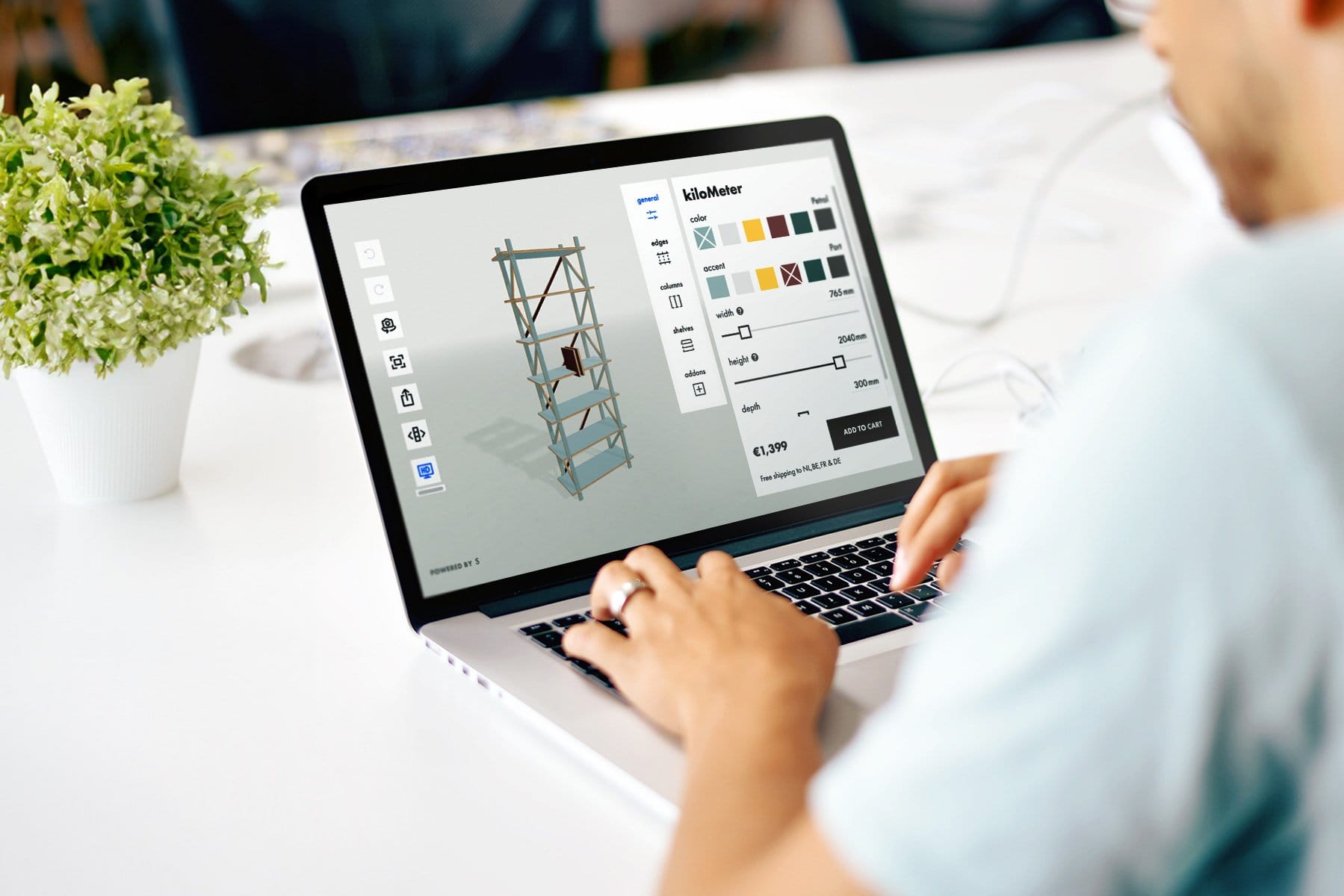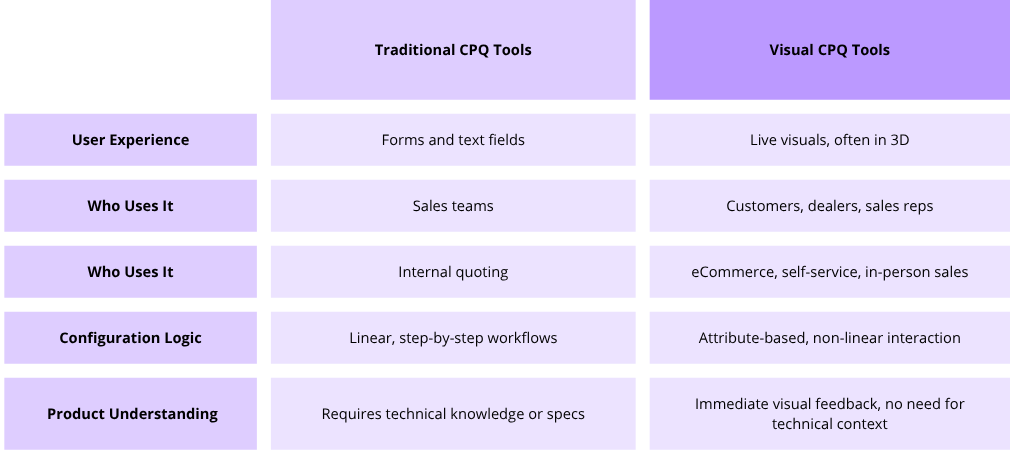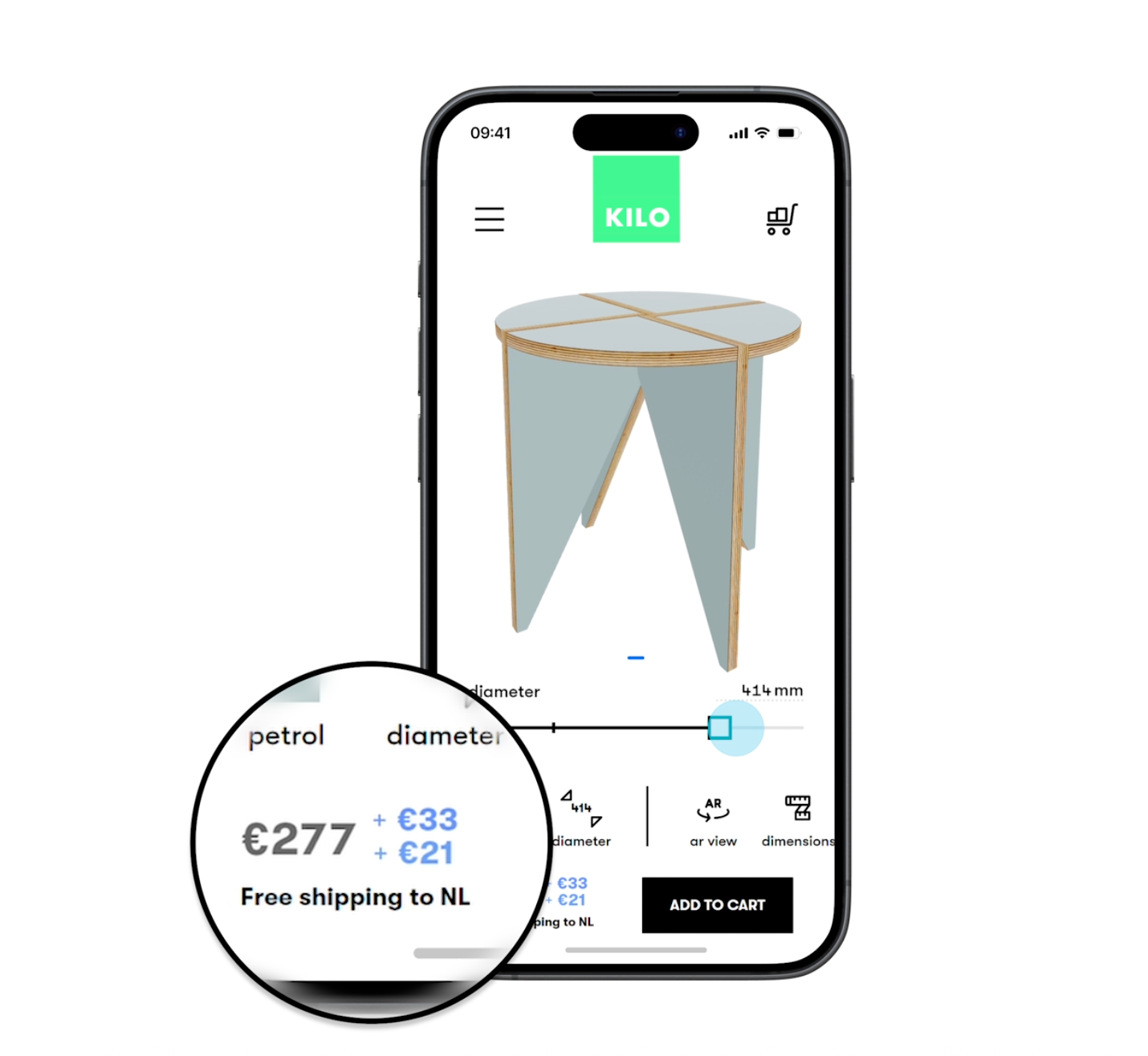Visual CPQ 101: All You Need to Integrate It Into Your Sales
Learn what Visual CPQ is, how it works, and what it takes to implement it. From 3D configuration to system integration, this guide breaks down everything manufacturers need to know to successfully adopt Visual CPQ.

Quoting customized products should take minutes, not days. Yet for many manufacturers, it's still a slow, manual process full of errors and back-and-forth.
Visual CPQ changes that. It combines real-time product configuration, instant pricing, and interactive 3D visuals into a single streamlined experience.
In this guide, we break down what Visual CPQ really is, how it works, and what it takes to make it part of your sales process.
What is CPQ?
CPQ stands for Configure, Price, Quote. It is a software that helps companies sell complex or customizable products by automating three core steps in the sales process.
First, it allows the product to be configured based on available options and constraints. Then, it calculates the price based on the selected configuration, pricing rules, and discounts. Finally, it generates a quote that reflects the configured product and its final price.
CPQ is commonly used in industries where manual quoting is time-consuming or error-prone, such as custom manufacturing, industrial equipment, or modular furniture. It replaces spreadsheets and manual processes with a centralized rule-based system that ensures accuracy and consistency.

What is Visual CPQ vs. Traditional CPQ Tools?
Traditional CPQ tools are typically used by sales teams through internal systems. They rely on text-based forms or step-by-step input fields to guide the pricing process. These tools are efficient but not designed for a smooth user experience.
Visual CPQ improves on this by adding a visual interface. Users can see the product as they configure it. Visualization is often in 3D, in this case called 3D CPQ. As different options are selected, the product updates in real time, making it easier to understand how selections affect the final outcome. This approach is more intuitive and is well suited for both sales teams and end customers.

Benefits of CPQ for Manufacturing
Implementing a 3D CPQ software impacts more than just your sales process. It brings value across teams by reducing manual work, improving accuracy, and creating a smoother path from product to customer.
For Sales
- Faster quoting: Sales reps can generate accurate quotes in minutes instead of hours.
- Fewer errors: Built-in rules prevent invalid configurations or pricing mistakes.
- Shorter sales cycles: Prospects move faster when there’s no back-and-forth to confirm options or prices.
- Improved onboarding: New sales reps can start selling complex products without deep product knowledge.
For Marketing
- More high-intent leads: When prospects use visual CPQ to customize a product and receive a price instantly, they show strong buying intent.
- Increase engagement on product pages: Allowing users to configure products and get immediate pricing keeps them engaged longer and interacting with your offering.
- Gain insights from user behavior: a CPQ software captures detailed information on preferred options and features, helping marketing teams refine targeting and messaging.
- Present complex products more clearly: 3D CPQ makes it easier to explain modular or customizable products.
For Product
- Centralized configuration logic: All product rules and dependencies are managed in one place.
- Easier updates: Changes to pricing or options sync across all sales channels automatically.
- Fewer support requests: Clear 3D configuration reduces questions and edge-case errors.
- Scalable product launches: Quickly roll out new variants without rebuilding the quoting process.

How Does a Visual CPQ Software Work?
A visual CPQ software combines product rules, pricing logic, and visual feedback into a single seamless flow that follows three main steps:
- Configure: Users customize a product through a CPQ configurator, selecting features, dimensions, and materials. Unlike standard forms, 3D CPQ allows users to see changes visually as they configure. The CPQ software validates selections in real time using constraints, dependencies, and logic defined for each product. This is especially valuable in B2B manufacturing, where products often have complex structures and rules.
- Price: Every change instantly updates the price. The CPQ pricing tool applies modifiers, conditional rules, and volume-based logic based on the active configuration. There is no need for manual price lookup or spreadsheet calculations.
- Quote: Once the configuration is complete, the system generates a detailed quote. It includes selected options, final pricing, SKUs, and any technical data. The quote can be used by sales teams or passed directly into ERP, CRM, or eCommerce platforms for processing.
Build vs. Partner: What’s the Best Way?
If you’re considering implementing a CPQ pricing tool, there are two paths forward: build it yourself, or work with a partner. There is no fully plug-and-play solution as CPQ requires customization, 3D asset development, and rule configuration.
Option 1: Build your own Visual CPQ in-house
Some companies choose to build a Visual CPQ system internally, usually led by a product or engineering team with help from 3D designers and front-end developers. This approach gives full control but comes with major responsibilities:
- You’ll need to develop a 3D viewer (usually using Three.js or similar), and build the UI layer (typically in React or Vue).
- You must manage pricing logic, backend logic, database, and integrations (CRM, ERP, etc.).
- 3D assets must be modeled, optimized, and maintained.
- You’ll be responsible for long-term updates and support.
Who builds their own? Usually, it’s large enterprises with in-house dev teams and the capacity to invest years into building and maintaining a solution. Without those resources already in place, developing from scratch is rarely the most efficient path.
Option 2: Partner with a CPQ provider
Most companies work with an external partner to build a custom Visual CPQ solution based on a reusable architecture. This partner handles the entire implementation: UI/UX, 3D modeling, product rules, pricing logic, and integrations.
You still need to provide configuration rules, pricing logic, and existing visual assets, but you don’t have to build the configurator from scratch. A good partner brings:
- A proven tech stack
- A repeatable process
- Experience with similar CPQ software for manufacturing
- The ability to scale the solution over time
Who partners? Companies that need a tailored Visual CPQ but don’t want to build or maintain it in-house. This includes small-to-large-sized manufacturers, DTC brands focused on visual shopping, and B2B sellers looking to automate complex quoting without hiring a dev team.

Future-Proof Your Sales with Salsita CPQ Configurator
Salsita CPQ configurator lets your sales reps, dealers, or customers configure complex products, see live pricing updates, and generate accurate quotes in real time. It handles all configuration rules and pricing logic behind the scenes, ensuring every selection is valid and production-ready.
As users interact with the product, the configurator updates visuals, applies constraints, calculates pricing, and prepares complete quote data. Everything is synced and ready to pass into your ERP, CRM, or production systems without manual steps.
If your sales process still depends on spreadsheets or manual quoting, now is the time to modernize. Salsita CPQ configurator gives you the accuracy, speed, and flexibility to sell more efficiently and at scale.
Ready to explore Visual CPQ for your business? Get in touch and let’s talk about your products:


